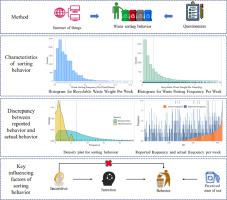Resources, Conservation and Recycling ( IF 11.2 ) Pub Date : 2021-07-10 , DOI: 10.1016/j.resconrec.2021.105775 Ziqian Xia , Si Zhang , Xi Tian , Yaobin Liu

|
Understanding the intention and behavior of individual is crucial to the effective implementation of waste sorting. Previous scholars mainly studied it through questionnaire research. This approach has a limited sample size, and the real behavior is difficult to quantify. In this paper, 180,417 drop-off data from 13,047 college students in the backend of Internet of Things (IoT) bins are analyzed in conjunction with 320 questionnaires. Technology Acceptance Model (TAM), Theory of Planned Behavior (TPB) and Norm Activation Model (NAM) are used together to analyze college students' waste sorting behavior. The results are as follows: (1) College students sort 0.426 kg recyclable waste per (personweek) in the investigated community, and the drop-off frequency of pre-class and mealtime is 46% higher than usual. (2) Due to the pressure of subjective norms, 75% of respondents reported a 220% higher frequency of 3–8 occasions per week than the actual situation. (3) The current incentive level (1 kg recyclables can exchange for a reward equivalent to 9 cents) cannot significantly regulate the relationship between waste sorting intention and behavior. (4) IoT and questionnaire data show that perceived ease of use could directly promote waste sorting intention and behavior. The findings provide a scientific basis for effectively improving the waste sorting behavior of the public.
中文翻译:

通过物联网了解垃圾分类行为及关键影响因素——来自大学生社区的证据
了解个人的意图和行为对于垃圾分类的有效实施至关重要。以往的学者主要通过问卷调查进行研究。这种方法样本量有限,真实行为难以量化。本文结合320份问卷,对物联网(IoT)垃圾箱后端13047名大学生的180417份流失数据进行了分析。结合技术接受模型(TAM)、计划行为理论(TPB)和规范激活模型(NAM)分析大学生垃圾分类行为。结果如下:(1)大学生每(人)分拣0.426公斤可回收垃圾周)在被调查社区,课前和进餐时间的下降频率比平时高 46%。(2) 由于主观规范的压力,75%的受访者表示每周3-8次的频率比实际情况高出220%。(3)目前的激励水平(1公斤可回收物可以换取相当于9美分的奖励)不能显着调节垃圾分类意图和行为之间的关系。(4) 物联网和问卷数据表明,感知易用性可以直接促进垃圾分类的意愿和行为。研究结果为有效改善公众的垃圾分类行为提供了科学依据。











































 京公网安备 11010802027423号
京公网安备 11010802027423号